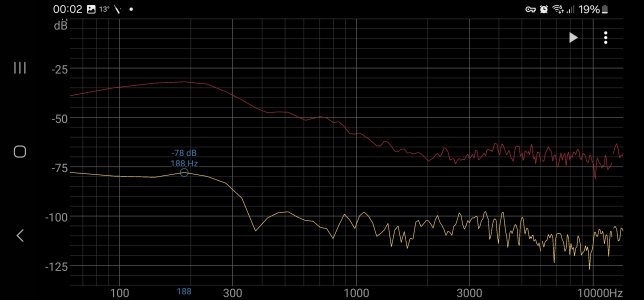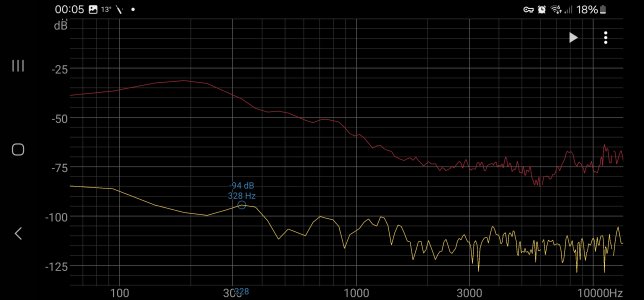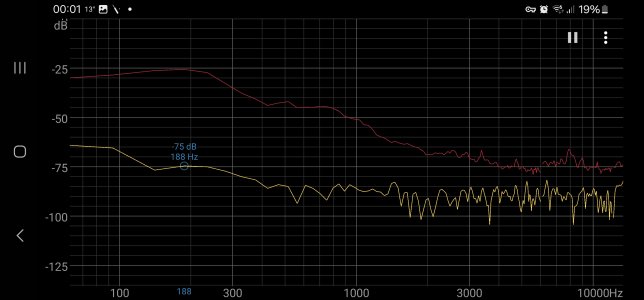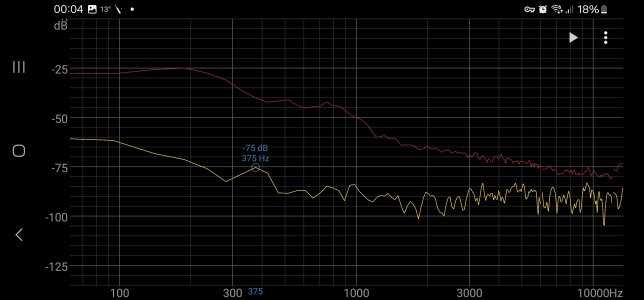The statement you stated can be produced and measured. How do they sound? That’s become subjective. But by definition what damping factor does to music you can use google to give you answer as well as sampling rate.And equally valid, you can measure, but can't hear it. For example, amplifier output impedance or damping factor, what does that sound like?
Let alone 96kHz or even 192kHz sampling rates.
You are using an out of date browser. It may not display this or other websites correctly.
You should upgrade or use an alternative browser.
You should upgrade or use an alternative browser.
My Ultra tests
- Thread starter onlyoneme
- Start date
Yes I know that, and what they are measurements of and theoretically therefore how they might influence SQ. You can easily measure these characteristics but can anyone reliably hear any difference. There's more than just considering the question if you hear it you can measure it, at which point do you stop hearing something you can measure. Those just happen to be two examples nothing more.The statement you stated can be produced and measured. How do they sound? That’s become subjective. But by definition what damping factor does to music you can use google to give you answer as well as sampling rate.
Well that depend how good is your ear. There some improvement on 96/192 but not night and day. Now, since I only listen to 5 songs for several decades any changes on those I would be able to know. The limitations is human ear not so on measurement.Yes I know that, and what they are measurements of and theoretically therefore how they might influence SQ. You can easily measure these characteristics but can anyone reliably hear any difference. There's more than just considering the question if you hear it you can measure it, at which point do you stop hearing something you can measure. Those just happen to be two examples nothing more.
Nope, plain and simple. It doesn't depend on how good your ear is if a higher damping factor can be heard or not.Well that depend how good is your ear.
I picked this one example because it's so easy and educational.
You again! That’s all you say?
DF changes with frequency and is most noticeable at lower frequencies. A high DF typically results in a tighter, more controlled bass, while a low DF results in soft or fat bass. A system where the damping factor of the entire loudspeaker/wire/amplifier circuit is very low will exhibit poor definition in the low frequency range.Nope, plain and simple. It doesn't depend on how good your ear is if a higher damping factor can be heard or not.
I picked this one example because it's so easy and educational.
You have to leave me...You again! That’s all you say?
I don't see what I could add to this great message which explains what I vaguely pointed out...
Ohhh you want a hug?You have to leave me...
I don't see what I could add to this great message which explains what I vaguely pointed out...
steadyshot
Major Contributor
- Joined
- Mar 14, 2023
- Messages
- 895
Weird thing . Never found a file at 24/192 that sounds good. Until 24/96 it sounds better than 16/44 but in my case 24/192 sounds the worse of all . Tested on Qobuz. Probably has to do with my gear. I use coax now
noOhhh you want a hug?
Any damping factor >20 is more than high enough. There's no point and no measurable or perceivable difference going any higher.DF changes with frequency and is most noticeable at lower frequencies. A high DF typically results in a tighter, more controlled bass, while a low DF results in soft or fat bass. A system where the damping factor of the entire loudspeaker/wire/amplifier circuit is very low will exhibit poor definition in the low frequency range.
Having high just look good on paper even it’s not audible.Any damping factor >20 is more than high enough. There's no point and no measurable or perceivable difference going any higher.
It’s free, you don’t want?
I think most of this high res are just bunch of upsampling.Weird thing . Never found a file at 24/192 that sounds good. Until 24/96 it sounds better than 16/44 but in my case 24/192 sounds the worse of all . Tested on Qobuz. Probably has to do with my gear. I use coax now
Having high just look good on paper even it’s not audible.
It’s ironic that the local ASR/SINAD champion states that.
Speaker damping is system (speaker and amp design) synergy dependent. Many systems work well with low numbered damping factors others do not. The ‘damping factor’ is very much an ASR metric or it should be to be consistent with their techno-limited view of how audio systems sound.
Toole has shown in 1975 that this is not the case, see above. Any speaker design relying on a low damping factor is simply broken. Any speaker design not working well with a typical damping factor of 40 (or more) is equally broken. In addition to what Toole explained back then, the influence of in-room speaker placement is far more important and the possibilities of modern EQ are well suited to counteract this.Speaker damping is system (speaker and amp design) synergy dependent. Many systems work well with low numbered damping factors others do not.
It's a modern or maybe not so modern myth that "big speakers" demand a "big amp" with an especially high DF.
I'm willing to accept two exceptions. Tube amps on one hand and cheapish class D amps where the DF might be insufficient when combined with speakers with a very low resonant frequency. In most other cases there is really very little to worry about.
You are repeating what I said and Toole says - system synergy is what matters and a single metric ‘damping factor’ doesn’t generally.Toole has shown in 1975 that this is not the case, see above. Any speaker design relying on a low damping factor is simply broken. Any speaker design not working well with a typical damping factor of 40 (or more) is equally broken. In addition to what Toole explained back then, the influence of in-room speaker placement is far more important and the possibilities of modern EQ are well suited to counteract this.
It's a modern or maybe not so modern myth that "big speakers" demand a "big amp" with an especially high DF.
I'm willing to accept two exceptions. Tube amps on one hand and cheapish class D amps where the DF might be insufficient when combined with speakers with a very low resonant frequency. In most other cases there is really very little to worry about.
We can absolutely agree on that.... and a single metric ‘damping factor’ doesn’t generally.
Personally I still avoid using the term synergy just because the number of exceptions is so much smaller than the number of combinations that work together just well. I hope that my previous posting didn't come across too harsh.
Having said that, I'm not talking against the concept of finding and matching components for best results.
What the hell are those then?DF changes with frequency and is most noticeable at lower frequencies. A high DF typically results in a tighter, more controlled bass, while a low DF results in soft or fat bass. A system where the damping factor of the entire loudspeaker/wire/amplifier circuit is very low will exhibit poor definition in the low frequency range.
Absolutely, because it's only part of an electromechanical spring and is meaningless without knowing the properties of the rest of the system.We can absolutely agree on that.
Personally I still avoid using the term synergy just because the number of exceptions is so much smaller than the number of combinations that work together just well. I hope that my previous posting didn't come across too harsh.
Having said that, I'm not talking against the concept of finding and matching components for best results.
This fat bass / loose bass is nonsense without the context of the electromechanical load (and if you want to really precise then the mechanical properties of the room also need to be included).
Anyway, back to the OP. I did some "independent" room tests given some very severe limitations in my measurement instruments, however, The baseline is my system is set to a flat target, and I have implemented RC using my Android phone and a Dayton imm-6C mic. I'm using Spectroid app and compared the S23 mic and the Dayton. The first 2 images are the Samsung mic, the second 2 are the Dayton. Ignore the lower yellow trace, it's the red max level we're interested in
The sound was a random Spotify white noise track, so that might be one (large) source of error (to be investigated). Not drawing any conclusions from this yet, other than it confirms what I already knew and that is that the S23 mic is not the same as the Dayton mic. I have installed the cal file for the Dayton, but I'm not sure that Spectroid uses that information, so let's assume not; however both show a very unflat room response givne that the Ultra has been through RC to a flat curve several times too.
It was too late to run a proper RC test with the Dayton attached to an independent recording device to verify the white noise source against the Wiim RC test tone signal. etc et, that's for another day
Actually, I should have posted this in the Android beta RC thread so apologies for dumping it here - will tidy up tomorrow


Dayton:


Similar threads
- Replies
- 48
- Views
- 2K
- Replies
- 8
- Views
- 869
- Replies
- 13
- Views
- 549
- Replies
- 35
- Views
- 1K
